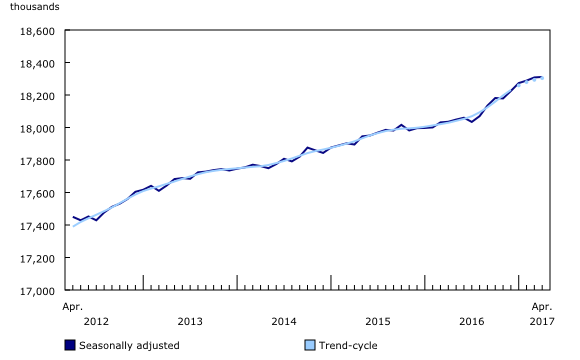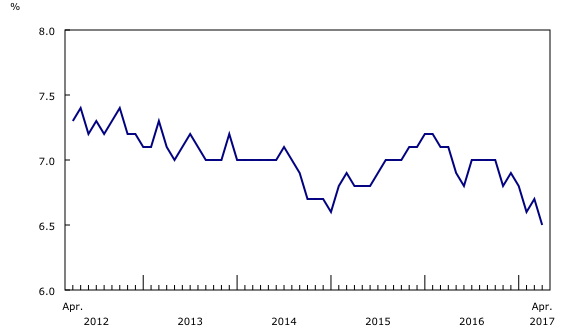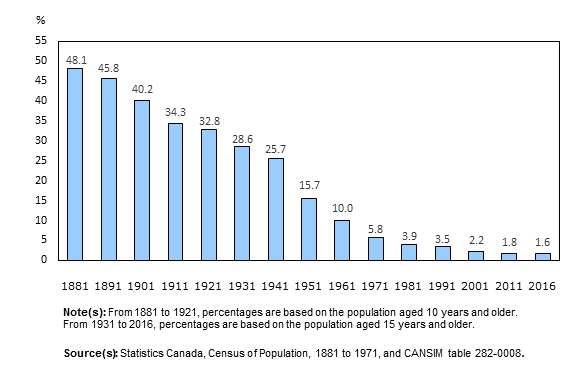Labour Force Survey, April 2017
Archived Content
Information identified as archived is provided for reference, research or recordkeeping purposes. It is not subject to the Government of Canada Web Standards and has not been altered or updated since it was archived. Please "contact us" to request a format other than those available.
Released: 2017-05-05
Employment was little changed in April, while the unemployment rate declined 0.2 percentage points to 6.5%, the lowest rate since October 2008. The decrease was mostly the result of fewer youth searching for work.
Compared with 12 months earlier, there were 276,000 (+1.5%) more people employed and the unemployment rate was 0.6 percentage points lower. Over the same period, the total number of hours worked rose 1.1%.
Highlights
In April, employment increased among people 55 and older, while it declined among men aged 25 to 54. Employment was little changed among women aged 25 to 54 and youths aged 15 to 24.
Employment rose in British Columbia and Prince Edward Island, while it was virtually unchanged in the other provinces.
More people were employed in educational services, health care and social assistance, and transportation and warehousing in April. At the same time, employment declined in business, building and other support services, as well as in accommodation and food services.
Public sector employment increased in April, while the number of private sector employees fell. Self-employment was little changed.
Demographic overview
Employment among the population aged 55 and older rose by 24,000 in April, mostly in full-time work, and their unemployment rate declined 0.6 percentage points to 5.6%. On a year-over-year basis, people 55 and older had the fastest rate of employment growth (+3.6% or +133,000) compared with the other demographic groups. This is primarily the result of the continued transition of the baby-boom cohort into this older age group.
For men aged 25 to 54, employment declined by 20,000 in April, mostly in full-time work, and their unemployment rate increased 0.3 percentage points to 6.1%. Since August 2016, their employment gains have totalled 81,000. On a year-over-year basis, their unemployment rate was down 0.4 percentage points.
Among women aged 25 to 54, employment held steady in April and their unemployment rate was little changed at 5.1%. Compared with 12 months earlier, employment for this group was up 71,000 (+1.2%), virtually all in full-time work.
Employment for youth aged 15 to 24 was little changed in April, while their unemployment rate fell 1.1 percentage points to 11.7% as fewer of them searched for work. This is the lowest unemployment rate for youth since September 2008. On a year-over-year basis, youth employment was virtually unchanged.
Provincial summary
In British Columbia, employment increased by 11,000 in April and the unemployment rate was little changed at 5.5%. Employment in the province has been on an upward trend with notable increases in four of the past five months. Compared with 12 months earlier, employment in British Columbia increased by 80,000 (+3.4%), mostly in full-time work.
There were an estimated 800 more people working in Prince Edward Island in April and the unemployment rate for the province was little changed at 10.3%. Prince Edward Island has had relatively strong employment growth since the autumn of 2016. On a year-over-year basis, employment in the province was up 2,500 (+3.5%).
In Ontario, employment held steady in April. The unemployment rate fell 0.6 percentage points to 5.8%, mostly due to a decline in the number of youth searching for work. This is the lowest unemployment rate for the province since January 2001. Compared with 12 months earlier, employment in Ontario was up 87,000 (+1.2%).
In Quebec, both the employment level and the unemployment rate were little changed in the month. In the 12 months to April, employment in the province rose by 88,000 or 2.1%, mostly in the second half of 2016. On a year-over-year basis, the unemployment rate in Quebec declined 0.8 percentage points to 6.6%.
Employment in Alberta held steady in April after a period of growth that began in autumn 2016. The unemployment rate in the province was 7.9% in April, down 0.5 percentage points from the previous month as fewer people searched for work.
Industry perspective
Employment in educational services rose by 19,000 in April, mostly in Ontario and British Columbia. This offset a similar-sized decline observed the previous month. Compared with 12 months earlier, there were 30,000 (+2.4%) more people working in educational services across Canada.
In health care and social assistance, employment increased by 12,000 in April, with the bulk of the growth in British Columbia. On a year-over-year basis, overall employment in this industry rose by 31,000 (+1.3%).
There were 8,800 more people working in transportation and warehousing in April. The increase was largely in Ontario. In the 12 months to April, there were 24,000 (+2.6%) more people working in this industry at the national level.
In contrast, employment in business, building and other support services fell by 19,000 in April, with declines primarily split between Quebec and British Columbia. Nationally, employment in this industry was virtually unchanged on a year-over-year basis. Business, building and other support services is a broad industry that includes, for example, administrative or cleaning services to buildings, as well as employment services.
Employment in accommodation and food services declined by 12,000 in April, mostly in Ontario and Quebec. For Canada as a whole, employment in this industry was slightly lower than in April 2016.
Public sector employment increased by 35,000 in April, largely in health care and social assistance and educational services. At the same time, the number of private sector employees fell by 51,000. On a year-over-year basis, the number of private sector employees rose by 152,000 (+1.3%), while public sector employment was up 92,000 (+2.6%).
Self-employment was little changed both in the month and compared with April 2016.

In celebration of the country's 150th birthday, Statistics Canada is presenting snapshots from our rich statistical history.
Evolution of employment in agriculture
The contribution of agriculture to total employment has declined throughout the history of the Canadian labour market. This long-term decline is related to numerous social and economic changes, involving technology, industrialization and urbanization.
In 1881, nearly half of all employed people (48%) worked in agriculture. This proportion fell precipitously over the subsequent decades, to just over one-quarter (26%) by 1941 and one-tenth (10%) by 1961. By the end of the 20th century, the proportion had fallen below 5%. As of 2016, the share of people employed in agriculture was 1.6%.
Using more recent data from the monthly Labour Force Survey can highlight changes in the type of work in agriculture. From 1976 to 2016, for example, the proportion of self-employed workers in this industry fell from 43% to 19%, while the proportion who had multiple jobs increased from 3% to 8%.
The population employed in agriculture has the highest median age of all industries. The median age—the age at which half of the population is above and half is below—increased from 41 years in 1976 to 50 years in 2016. In comparison, the median age of all employed people increased from 33 years in 1976 to 41 years in 2016.
Sources: Census of Population, 1881 to 1971, and Labour Force Survey (3701).
Note to readers
The Labour Force Survey (LFS) estimates for April are for the week of April 9 to 15.
The LFS estimates are based on a sample and are therefore subject to sampling variability. As a result, monthly estimates will show more variability than trends observed over longer time periods. For more information, see "Interpreting Monthly Changes in Employment from the Labour Force Survey." Estimates for smaller geographic areas or industries also have more variability. For an explanation of the sampling variability of estimates and how to use standard errors to assess this variability, consult the "Data quality" section of the publication Labour Force Information (71-001-X).
This analysis focuses on differences between estimates that are statistically significant at the 68% confidence level.
The LFS estimates are the first in a series of labour market indicators released by Statistics Canada, which includes indicators from programs such as the Survey of Employment, Payrolls and Hours (SEPH), Employment Insurance Statistics, and the Job Vacancy and Wage Survey. For more information on the conceptual differences between employment measures from the LFS and SEPH, refer to section 8 of the Guide to the Labour Force Survey (71-543-G).
The employment rate is the number of employed people as a percentage of the population aged 15 and older. The rate for a particular group (for example, youths aged 15 to 24) is the number employed in that group as a percentage of the population for that group.
The unemployment rate is the number of unemployed as a percentage of the labour force (employed and unemployed).
The participation rate is the number of employed and unemployed as a percentage of the population.
Full-time employment consists of persons who usually work 30 hours or more per week at their main or only job.
Part-time employment consists of persons who usually work less than 30 hours per week at their main or only job.
Seasonal adjustment
Unless otherwise stated, this release presents seasonally adjusted estimates, which facilitate comparisons by removing the effects of seasonal variations. For more information on seasonal adjustment, see Seasonally adjusted data – Frequently asked questions.
Chart 1 shows trend-cycle data on employment. These data represent a smoothed version of the seasonally adjusted time series, which provides information on longer-term movements, including changes in direction underlying the series. These data are available in CANSIM table 282-0087 for the national level employment series. For more information, see the StatCan Blog and Trend-cycle estimates – Frequently asked questions.
Next release
The next release of the LFS will be on June 9.
Products
A more detailed summary, Labour Force Information (71-001-X), is now available for the week ending April 15.
More information about the concepts and use of the Labour Force Survey is available online in the Guide to the Labour Force Survey (71-543-G).
The updated Labour Market Indicators dashboard (71-607-X) is now available. This new, interactive dashboard provides easy, customizable access to key labour market indicators. Users can now configure an interactive map and chart showing labour force characteristics at the national, provincial or census metropolitan area level.
The article "Annual review of the labour market, 2016", released April 28 in the Labour Statistics: Research Papers series (75-004-M), provides an analysis of current labour market trends using a combination of major indicators from the Labour Force Survey; the Survey of Employment, Payrolls and Hours; the Job Vacancy and Wage Survey; and Employment Insurance statistics.
Contact information
For more information, contact us (toll-free 1-800-263-1136; 514-283-8300; STATCAN.infostats-infostats.STATCAN@canada.ca).
To enquire about the concepts, methods or data quality of this release, contact Andrew Fields (613-951-3551; andrew.fields@canada.ca), Vincent Ferrao (613-951-4750; vincent.ferrao@canada.ca) or Client Services (toll-free 1-866-873-8788; statcan.labour-travail.statcan@canada.ca), Labour Statistics Division.
- Date modified:






